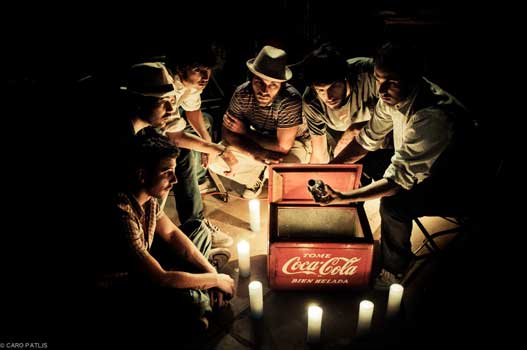Commercial photography has undergone major transformations since the advent of digital technology. From the growth of the “amateurs-for-hire” (who some analysts identify as potential threat to the industry) to Kodak filing for bankruptcy, the condition of the photography industry is extremely clear – and not particularly promising for new business ventures. So why start a new photography agency? Well, there are, it turns out, some compelling reasons.
W
We are living in a digital world and photography is perhaps the starkest example of this. Did you know that today more images are created every two minutes than were created during the entire nineteenth century? In the US, the percentage of photos taken with camera phones continues to grow. Conversely, the percentage of photos taken with point-and-shoot cameras continues to fall. In 2010 camera phones accounted for 17 percent of photographs while in 2011 they accounted for 27 percent. In 2010, 52 percent of photographs were taken by point-and-shoot cameras; in 2011 that number dropped to 44 percent. (petapixel data)

photo Sofie Barfoed
All of these digital photos are stored on the Web. Facebook is the biggest photo library online with 300 million photos added every day as of March 2012, and 140 BILLION photos stored in total. That is ten thousand times larger than the photo archive of the Library of Congress. Sixty new photos are added on Instagram every second.
In the midst of this explosion, the commercial photography industry as a whole is showing signs of life. According to industry analysts, 2010 saw the photo industry recover to pre-2009 levels. One indicator is the number of photos captured per month by professional shooters, which, different sources report, trended up in 2011. Industry observer IBISWorld projects steady growth in revenues to $10.1 billion by 2016. Despite rising demand for professional photography, however, competition from amateurs is increasing. While photographers are benefiting from the changes by increasing their efficiency and availability, consumers are now able to take professional quality images themselves, without the need for professionals in the industry.
Even advertising agencies have suffered over the past five years with the decline in corporate advertising spending representing just one dramatic change in how people consume
media. However, now, revenues have started to recover and should continue to rise over the next five years as firms adapt to the changing environment. From the numbers of the British Council Industry Survey of Photographers we can appreciate how over the last 20 years it has become more difficult to enter the industry.
For example, 39 percent of photographers in 2010 had a separate income, and two of every five freelancers had an additional income stream outside photography. Overall one in five earned less than half of their income as photographers. Statistics show that the majority of photographers will at some point in their working life seek employment outside this industry. Analysis also shows that a significant amount of photographers entered the industry at an age later than 20-30.
So, what happens if the consumer can shoot his own family or product with his DSLR upgrade and is satisfied with the images? What’s left for the pro shop? Experts say that aside from pro-level skills and the acquisition of higher-end cameras and lenses, digital technology continues to give pro shooters more and faster options to meet their customers’ needs. Successful commercial photographers must continue to identify new markets, including ways and means to separate their work from that of price-cutting, entry-level shooters. And, in the years to come, they must look for new business opportunities in post-production services, image sharing, image storage and printing, and the continued implementation and sales of personalised photoproducts that serve the market.
Why would two women in their twenties decide to start a photography business in this environment? Simply put, I do not think professional photography is dying. I do believe we have to rewrite the model and structure of our businesses to embrace change and seek new market needs. That is part of the reason why we represent young, up-and-coming artists. The ability of the young generation of image-makers to move seamlessly between photography, video, and new media allows them to change the old definition of photography. There are no real stats on the turnover in the industry really, such as the loss of revenue due to the stock library images that now sell at very low prices, or the impact of open source imagery (often provided by the growing number of amateur websites that offer photographs for free only in return of a photo-credit mention). Many commissions no longer exist as designers can base campaigns on freely available photography, rather than creating photographs to fit a campaign. I don’t believe that with the increase of photographers in the market, the quality of images has diminished. I feel the quality of published work has.
There is no doubt that in purely numerical terms photography is one of the most competitive industries around. Photographers are competing against more people each year for a smaller amount of work. Marketing at this point is essential, the photographer’s or agency’s image is as important as the work they produce. The future of image-makers will lie in the convergence of skills and the diversification of creative output. A single style is no longer dominating the market. This gives artists more room to be creative and offers more people the opportunity to exhibit and sell their work.
This is how Silverlake Photography was born: with a passion for visual arts, a different perspective towards the industry, and a pinch of courage.
The adventure started when I visited my friend Maureen Audetto in Singapore during the spring of 2012. She had been living in Asia for a year and was just about to relocate to Europe. We talked about the future, our plans and dreams, and found ourselves to be in very similar situations; we both wanted to start something new and exciting. On one side, I had recently finished my Masters in photography in New York City and was struggling to find a place in the photography world in Italy, where I was living at that moment. On the other side, Maureen had gained some experience working in a photography production agency in Singapore, had fallen in love with the visual arts, and wanted to keep working in the industry. One thing led to another and the contagious excitement of potentially starting an activity together made us meet again a few days later, this time in England. There we decided to register and set up our baby: Silverlake Photography.
Maureen had just decided to live in London and I knew I would always be in Rome and New York, my two inspirational metropolises. We brainstormed ideas and found what we now believe to be our competitive advantage, differentiating us from other photography agencies. Having the opportunity to live in different continents, we decided to represent talents from across the world, providing our clients with services anywhere and everywhere. We also agreed that up-and-coming digital image-makers are the new great generation of visual artists. They represent the next big thing in terms of style and visual vibe, so we searched for young international artists who were looking for representation.
Through my studies in photography, I had the luck to meet a very talented group of photographers from Argentina, Paraguay, Greece, France, Denmark and many other countries. This was key to the success of our initiative.
We now officially represent ten talents, based in seven different countries – all of them very different from each other, but all very passionate about what they do. Our goal is to help these talented artists grow and gain exposure internationally. We work on a commission basis, finding clients jobs in anything from editorial to advertising. To complement the agency structure, we also offer our clients a wide range of production services – managing budgets, sourcing models, locations and make- up artists, and providing post-production services. Another important aspect of our agency is social media, a key ingredient to a successful contemporary business. We have created a strong platform through Facebook, Instagram, Twitter and Pinterest and we hope that together with our website, this will help us create a rising creative presence in the industry.
SilverLake Photography also has an ambition to help raise awareness of community, charity and social issues throughout the world. We are now collaborating with BNE Water Foundation (www.bnewater.org) among others. We discovered this organisation on Twitter. It is a charity organisation that helps impoverished communities gain access to clean water and sanitation by selling artists’ works online. We are working right now on donating fine art prints to sell online and we hope this will be a long-term collaboration.
The reason we started this company – even if right now might not be the best moment to enter the industry (on paper, anyway) – is that the creative world will always need image makers, however those images are made: with a point-and-shoot camera, a Polaroid, a large format camera, a pinhole camera, a SLR or a phone camera. The creativity rather than tech skills will denote successful photographers in the years to come.






















